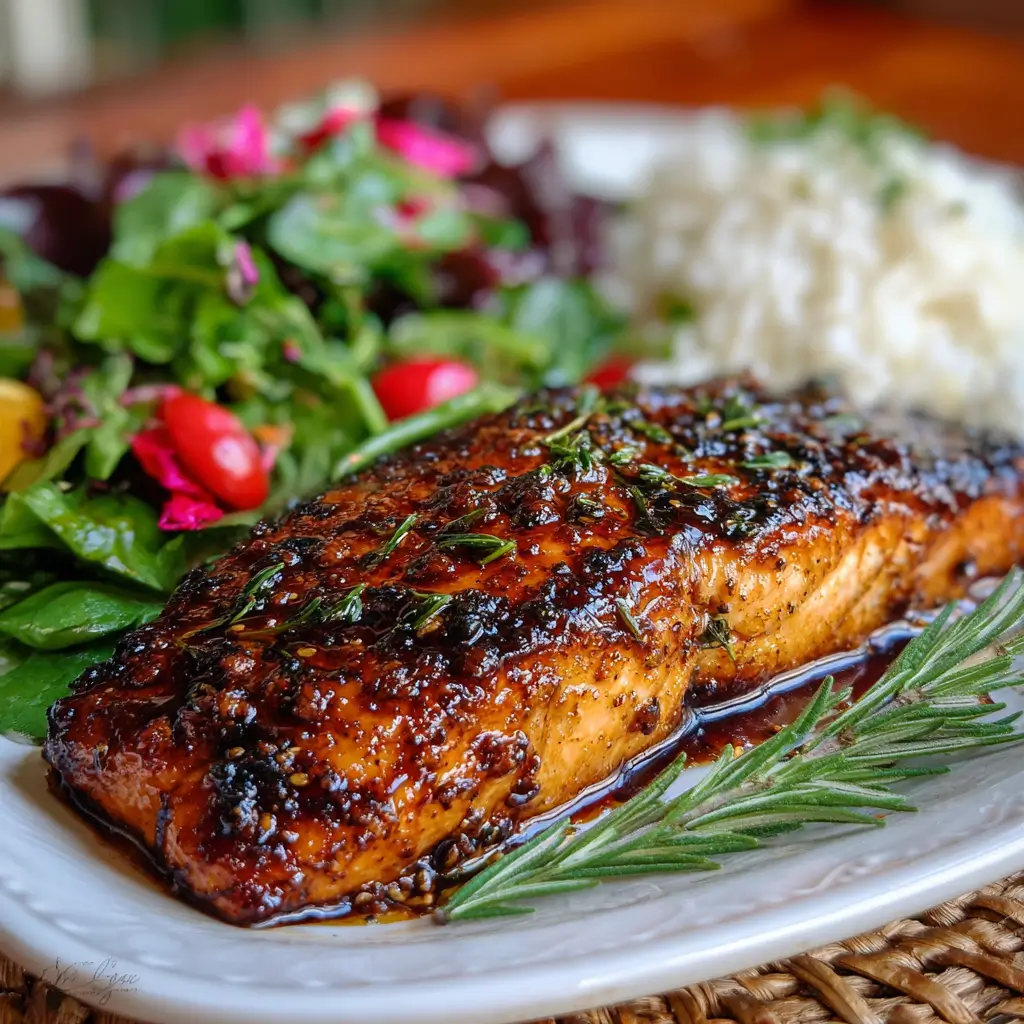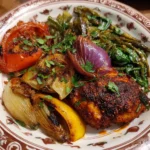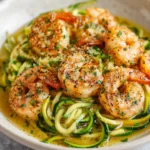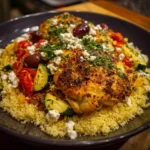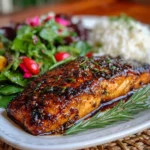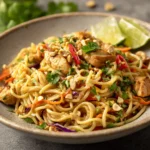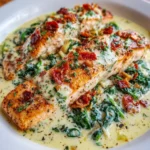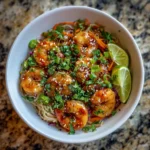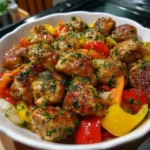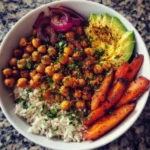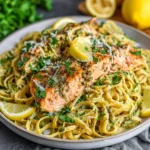Balsamic Honey Glazed Salmon: A Perfect Harmony of Sweet, Tangy, and Savory
Indulge in the rich flavors of Balsamic Honey Glazed Salmon—a dish that effortlessly elevates a weeknight dinner into a gourmet experience. This recipe combines the natural richness of salmon with a luscious glaze made from balsamic vinegar and honey, creating a perfect balance of sweet, tangy, and savory notes. Whether you’re cooking for family, hosting guests, or simply treating yourself, this dish is sure to impress with its vibrant color, elegant presentation, and melt-in-your-mouth texture. Not only is it delicious, but it’s also packed with heart-healthy omega-3 fatty acids and essential nutrients, making it a smart choice for anyone seeking both flavor and wellness.
The History of Balsamic Glazes and Salmon in Modern Cuisine
The use of balsamic vinegar dates back to 11th century Italy, where it was traditionally aged in wooden barrels for years, developing deep complexity and sweetness. Originally reserved for nobility, modern commercial versions have made this luxurious ingredient accessible worldwide. The pairing of balsamic vinegar with proteins like salmon gained popularity in the late 20th century as Mediterranean cuisine influenced global food trends. Honey, one of the oldest known natural sweeteners, complements balsamic beautifully, softening its acidity while enhancing umami depth. When combined, these two ingredients form a glaze that not only enhances flavor but also creates a glossy, restaurant-quality finish on fish.
Salmon itself has been a dietary staple for centuries, especially among Indigenous peoples of the Pacific Northwest and Scandinavian coastal communities. Its rise in global popularity began in the mid-20th century with advances in aquaculture and refrigeration. Today, balsamic honey glazed salmon represents a fusion of ancient traditions and contemporary culinary innovation—where heritage meets health-conscious cooking in a single, delectable dish.
Ingredients Breakdown: Why Each Component Matters
The magic of this recipe lies in the careful selection and synergy of high-quality ingredients. Let’s explore each component and its role:
- Fresh Salmon Fillets: Choose center-cut fillets with even thickness (about 6 oz each) for consistent cooking. Wild-caught salmon offers a richer flavor and firmer texture, while farmed provides more fat content, resulting in juicier results.
- Balsamic Vinegar: Opt for aged balsamic vinegar (tradizionale style if possible) for a deeper, syrupy flavor. Avoid cheap versions with added sugars or caramel coloring, which can burn easily.
- Honey: Raw, unfiltered honey adds floral notes and helps caramelize the glaze. Manuka or orange blossom honey can add unique aromatic layers.
- Olive Oil: Extra virgin olive oil brings richness and aids in searing the salmon evenly without sticking.
- Fresh Garlic: Adds pungent depth; minced finely so it integrates smoothly into the glaze.
- Lemon Juice: Brightens the entire dish, cutting through the richness and balancing sweetness.
- Dijon Mustard: Acts as an emulsifier and adds a subtle sharpness that enhances the complexity of the glaze.
- Sea Salt & Black Pepper: Essential seasonings that enhance all other flavors without overpowering them.
- Fresh Herbs (optional): Thyme or rosemary infuse earthy tones during cooking, while chopped parsley or chives add freshness at the end.
Each ingredient plays a crucial role—not just in taste, but in texture, appearance, and overall mouthfeel—making this dish a masterclass in balanced cooking.
Step-by-Step Recipe: Crafting the Perfect Balsamic Honey Glazed Salmon
- Preparation: Begin by patting the salmon fillets dry with paper towels. Moisture is the enemy of a good sear, so thorough drying ensures crisp edges. Season both sides lightly with sea salt and freshly ground black pepper. Set aside.
- Make the Glaze: In a small saucepan over medium heat, combine 1/4 cup balsamic vinegar, 3 tablespoons honey, 1 tablespoon Dijon mustard, 2 minced garlic cloves, 1 tablespoon fresh lemon juice, and 1 teaspoon olive oil. Whisk continuously until the mixture begins to simmer and thicken slightly—about 5 minutes. Reduce heat to low and keep warm. (Note: Do not over-reduce now, as it will continue to thicken when applied to the salmon.)
- Preheat Pan: Heat a large oven-safe skillet (preferably cast iron or stainless steel) over medium-high heat. Add 1 tablespoon of olive oil and swirl to coat the surface evenly.
- Sear the Salmon: Place the salmon fillets skin-side down (if skin-on) into the hot pan. Press gently with a spatula for the first 10 seconds to ensure full contact. Sear undisturbed for 4–5 minutes until golden brown and crisp. Use a thin metal spatula to check progress carefully.
- Flip and Glaze: Carefully flip the fillets using a spatula. Brush a generous amount of the warm balsamic honey glaze over the top of each piece. If using herbs, add a sprig of thyme or rosemary to the pan for aroma.
- Finish in Oven: Transfer the skillet to a preheated oven at 375°F (190°C). Bake for 8–10 minutes, depending on thickness, until the internal temperature reaches 125–130°F (52–54°C) for medium-rare, or up to 140°F (60°C) for well-done. The glaze should be shiny and slightly caramelized.
- Rest and Serve: Remove from oven and let rest for 3–5 minutes. Drizzle with additional warm glaze, a squeeze of fresh lemon juice, and garnish with chopped parsley or microgreens.
Tips for Success: Mastering the Art of Glazing Salmon
- Don’t Overcook the Salmon: Salmon continues to cook after removal from heat due to residual warmth. Pull it out just before reaching your desired doneness.
- Control the Glaze Consistency: If the glaze becomes too thick, thin it with a teaspoon of water or broth. If too thin, simmer longer until it coats the back of a spoon.
- Use Skin-On Fillets for Crispiness: The skin protects the flesh during searing and crisps beautifully. After cooking, it can be served or easily removed.
- Avoid Burning the Glaze: High sugar content means honey can burn quickly. Keep the heat moderate and monitor closely during baking.
- Skillet Choice Matters: Non-stick pans may prevent proper browning. Cast iron or stainless steel deliver superior sear and better heat retention.
- Double the Glaze: Make extra glaze to serve on the side—it pairs wonderfully with rice, quinoa, roasted vegetables, or even grilled asparagus.
- Room Temperature Start: Allow salmon to sit at room temp for 15–20 minutes before cooking for more even heating.
Variations and Customizations: Make It Your Own
This versatile recipe welcomes creativity. Here are some inspired variations:
- Spicy Kick: Add 1/2 teaspoon red pepper flakes or a dash of sriracha to the glaze for heat lovers.
- Orange Infusion: Replace half the lemon juice with fresh orange juice and add a teaspoon of grated orange zest for citrus brightness.
- Maple Twist: Substitute maple syrup for honey for a deeper autumnal flavor—ideal for fall and winter meals.
- Herb-Forward Version: Stir in chopped fresh basil, tarragon, or dill into the glaze just before serving.
- Asian Fusion: Add 1 teaspoon soy sauce or tamari and 1/2 teaspoon grated ginger to the glaze for an umami-rich twist.
- Smoked Salmon Option: While not suitable for glazing, flaked smoked salmon can be used in salads topped with a cold version of the dressing.
- Grilled Method: Cook on a preheated grill over indirect heat. Brush glaze in the last 5 minutes to avoid flare-ups.
- Dairy-Free & Paleo-Friendly: This recipe is naturally compliant—just ensure your mustard is free from additives.
Health Considerations and Nutritional Value
Balsamic Honey Glazed Salmon isn’t just delicious—it’s a powerhouse of nutrition. Here’s what makes it a healthy addition to your diet:
- Omega-3 Fatty Acids: Salmon is one of the best sources of EPA and DHA, which support brain health, reduce inflammation, and promote cardiovascular wellness.
- High-Quality Protein: A 6-ounce fillet contains about 34 grams of protein, essential for muscle repair and satiety.
- Heart-Healthy Fats: Monounsaturated fats from olive oil and omega-3s contribute to improved cholesterol levels.
- Antioxidants: Balsamic vinegar contains polyphenols that combat oxidative stress. Honey also has mild antibacterial and antioxidant properties.
- Low in Carbohydrates: With only ~8g net carbs per serving (mostly from honey), this dish fits well within keto and low-carb lifestyles when portion-controlled.
- Vitamins and Minerals: Rich in vitamin D, selenium, B12, potassium, and magnesium.
Cautions: Those managing blood sugar should monitor honey intake. Diabetics may consider reducing honey to 1–2 tablespoons and using a sugar substitute like monk fruit syrup. Additionally, individuals on blood thinners should consult their doctor regarding increased vitamin K intake from leafy greens often paired with this dish.
Full Ingredient List
- 4 (6 oz) salmon fillets, skin-on or skinless
- 1/4 cup high-quality balsamic vinegar
- 3 tablespoons raw honey
- 1 tablespoon Dijon mustard
- 2 cloves garlic, minced
- 1 tablespoon fresh lemon juice
- 2 teaspoons extra virgin olive oil (plus 1 tbsp for searing)
- 1 teaspoon fresh thyme leaves (or 1/2 tsp dried)
- Sea salt and freshly ground black pepper, to taste
- Fresh parsley or chives, chopped (for garnish)
- Lemon wedges (for serving)
Detailed Cooking Directions
- In a small saucepan, combine balsamic vinegar, honey, Dijon mustard, garlic, lemon juice, 2 tsp olive oil, and thyme. Bring to a gentle simmer over medium heat, stirring frequently. Reduce heat and let bubble softly for 4–5 minutes until the mixture thickens slightly and coats the back of a spoon. Remove from heat and set aside.
- Pat salmon fillets dry and season both sides with salt and pepper. Let stand at room temperature for 15 minutes.
- Preheat oven to 375°F (190°C).
- Heat 1 tablespoon olive oil in an oven-safe skillet over medium-high heat until shimmering.
- Place salmon fillets in the pan, skin-side down (if applicable), pressing gently for even contact. Sear for 4–5 minutes until deeply golden and crispy.
- Flip the fillets carefully. Brush generously with the prepared glaze.
- Transfer the skillet to the preheated oven. Bake for 8–10 minutes, or until the salmon flakes easily with a fork and reaches your preferred internal temperature.
- Remove from oven and rest for 3–5 minutes. Drizzle with additional warm glaze and garnish with herbs and lemon wedges.
- Serve immediately alongside roasted vegetables, mashed sweet potatoes, wild rice, or a crisp green salad.
Frequently Asked Questions (FAQ)
Can I make this recipe ahead of time?
Yes! Prepare the glaze up to 3 days in advance and store it in a sealed jar in the refrigerator. Reheat gently before using. However, cook the salmon fresh for best texture.
Can I bake the salmon without searing?
Absolutely. For a simpler method, place seasoned salmon on a parchment-lined baking sheet, brush with glaze, and bake at 400°F (200°C) for 12–15 minutes. The crust won’t be as crisp, but the flavor remains excellent.
Is frozen salmon okay to use?
Yes, but thaw it slowly in the refrigerator overnight. Never cook frozen salmon directly unless specified by packaging, as it leads to uneven texture.
How do I know when salmon is done?
The FDA recommends cooking salmon to an internal temperature of 145°F (63°C). However, many chefs prefer 125–130°F (52–54°C) for medium-rare, moist results. The flesh should flake easily with light pressure.
Can I air fry this salmon?
Yes! Air fry at 370°F (188°C) for 8–10 minutes, flipping halfway and glazing in the last 3 minutes to prevent burning.
What sides go well with balsamic honey glazed salmon?
Excellent pairings include garlic sautéed spinach, quinoa pilaf, roasted Brussels sprouts, grilled zucchini, herbed couscous, or a simple arugula salad with shaved Parmesan.
Can I use other fish?
Yes—this glaze works beautifully on halibut, trout, cod, or sea bass. Adjust cooking times accordingly based on thickness and flakiness.
Summary
Balsamic Honey Glazed Salmon delivers an exquisite blend of sweet, tangy, and savory flavors in a nutritious, omega-3-rich package. Easy enough for weeknights, elegant enough for entertaining—it’s a must-have recipe for every home cook.
